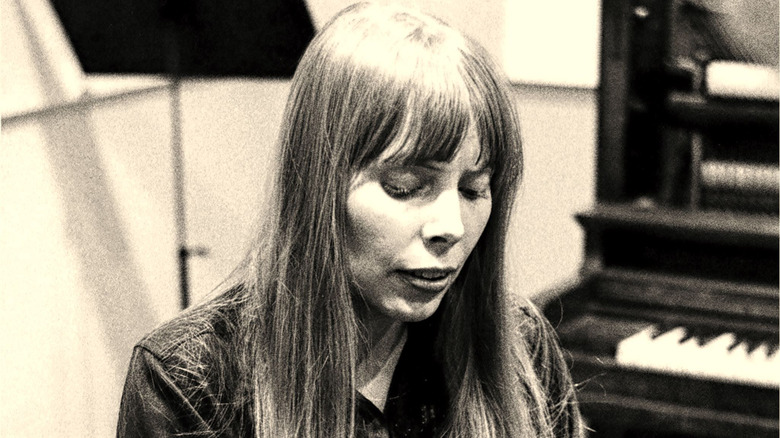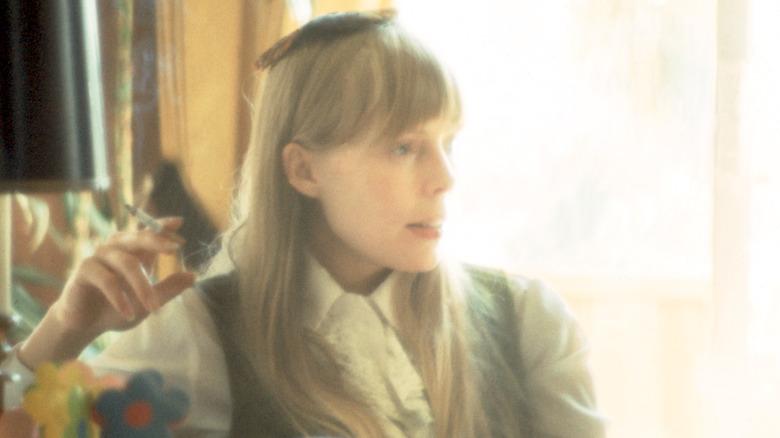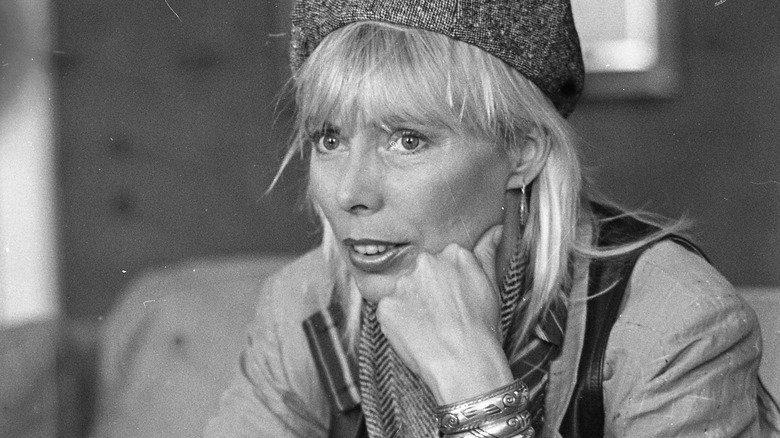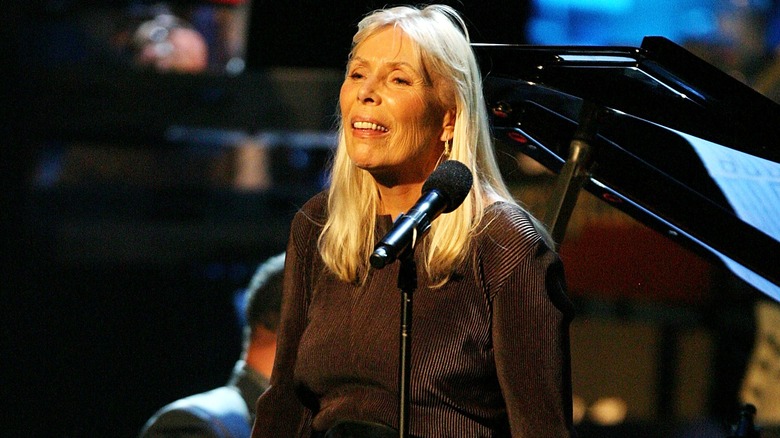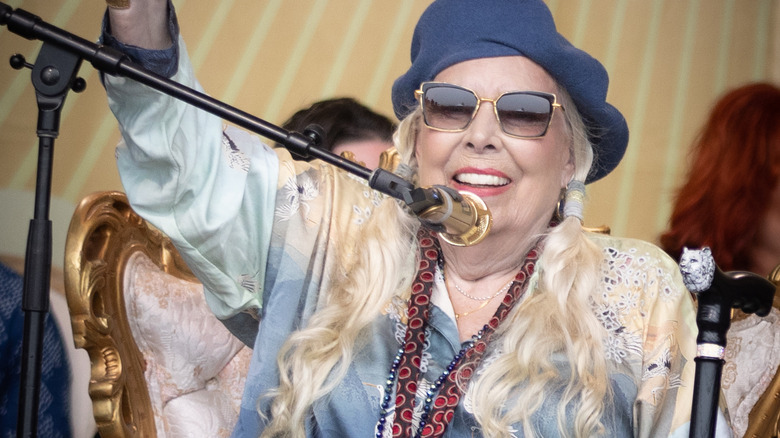Tragic Details About Joni Mitchell
With her singular, limber voice, unhindered phrasing, and distinct guitar tunings, Joni Mitchell has created a legacy of songwriting unique to itself. A truly creative and lifelong artist, Mitchell managed to carve out an incomparable space amidst the tidal wave of singer-songwriters splashing into the music scene of the late 1960s and 1970s. But her rise to music stardom was not an easy — or particularly fast — climb.
Her life, much like the music that has garnered her countless awards throughout her career, has been an eccentric amalgamation of periods of vulnerability, years of experimentation, and a consistent devotion to her creative muse above all else. Though her presence in the public eye has wavered from global superstar to reclusive relic and more in between, her impact on the world culturally, socially, and musically is undeniable and significant.
Raised in the rural plans of central Canada, Mitchell would endure several hardships that would ultimately shape her into the artist she is known as today. From her isolated upbringing to various medical scares over the years, these arduous experiences have been keenly reflected in her decades' worth of musical and visual artwork.
Joni Mitchell dealt with childhood polio effects all her life
As a young girl living in Saskatoon, Saskatchewan, Joni Mitchell — born Roberta Joan Anderson — fell victim to a widespread polio epidemic that was affecting much of Canada and the United States. "My spine was twisted up like a train wreck. I couldn't walk. I was paralyzed," Mitchell said in a 1995 interview with Star. Only nine years old at the time, this was also when Mitchell would pick up her lifelong habit of smoking cigarettes.
She eventually recovered from the debilitating childhood illness, but the virus never went away fully. Mitchell, along with hundreds of thousands of other adults who had polio as children, later suffered from post-polio syndrome. About 60 percent of all childhood polio survivors deal with this syndrome, which mimics the original symptoms of the disease. Mitchell's post-polio syndrome confined her to a wheelchair just like it did when she was a young girl.
By this time, Mitchell had already taken a significant step back from the limelight compared to her heyday in the 1970s. But this recurring medical issue marked an even further move out of the public eye, with Mitchell remarking to the Star that she needed to protect her limited physical and mental resources, and had turned to New Age treatments. ""I have to guard my energy," she said.
She struggled to find her place after graduating high school
Joni Mitchell attended elementary and high school in Saskatchewan but was never a particularly academic student. In a phone interview with Immaculate Heart College in Los Angeles, California published on her website, Mitchell credited a radical art teacher for helping shape her creative expression into something tailored but unbound by societal expectations or norms. While this stoked her rebellious nature, it did little to boost her performance in other subjects.
Mitchell failed her first attempt at the 12th grade before graduating late and moving on to undergraduate art studies at the Alberta College of Art in Calgary. The future folk icon found herself at the top of her class, which she attributed to her previous training in technical aspects of art. Despite being an honors student for the first time in her educational career, Mitchell felt like she failed to deliver in regard to free creativity.
"I seemed to be marked for my technical ability so that in free classes where I was really uninspired, my marks remained the same standard," Mitchell recalled during the interview. "Whereas people who were great in free class, who were original and loose, who didn't have the chops in a technical class, would receive a mark that was pretty similar to their technical ability. So, I became pretty disillusioned with art college, even though I enjoyed being near the head of my class for the first time in my life."
Joni gave up her child for adoption after being abandoned by her partner
Joni Mitchell, then known as Joan Anderson, began pursuing music after dropping out of the Alberta College of Art, which eventually led her to a rundown Toronto boarding house. She lived there with Brad MacMath, her boyfriend and fellow artist, with whom she got pregnant in 1964. Kelly Dale Anderson, named after the shade of Kelly green, was born on February 19, 1965. As Mitchell alludes in her song "Little Green," MacMath left her and her baby for California.
At a time when single mothers were largely frowned upon, Mitchell attempted to steady the boat by marrying a contemporary folk singer, Chuck Mitchell. The marriage only lasted a couple of years, but Mitchell's time with her daughter was even shorter. The rising folk star placed her baby, who would later be renamed Kilauren Gibb, up for adoption at six months old.
Mitchell eventually reunited with her daughter when Kilauren was 32, per a Maclean's profile on the singer and her long-lost child in 1997. The highly publicized homecoming came at a cost, with the press quickly hounding Gibb, her adopted family, and Mitchell's parents. "I've had pain and joy in my life, but nothing like this," Mitchell said of the experience. "It's an unparalleled emotional feeling."
A mysterious skin condition forced her to put music on hold in the early 2000s
Though she never achieved the same charting power of her early releases, Joni Mitchell continued to work consistently throughout the late 1990s and early 2010s. Her music grew more experimental and jazz-centric with each new album, and she began incorporating interesting collaborations, like her 2007 partnership with the Alberta Ballet in Calgary. The folk singer worked with choreographer Jean Grand-Maître to create "The Fiddle and the Drum," inspired by Mitchell's song of the same name.
Mitchell released a DVD documenting the production and her music in 2009, the same year she announced she would be leaving the music industry due to a mysterious skin condition called Morgellons. The Mayo Clinic states that those who think they suffer from Morgellons believe that parasites or fibers are emerging from their skin, though they note that some doctors treat it as a mental condition, calling it a delusional infestation.
Frustrated at the lack of knowledge and support from the medical community, Mitchell started the Morgellons Research Foundation, which led a successful campaign to kickstart research by the Centers for Disease Control and Prevention. The CDC's findings, however, classified the condition that Mitchell was raising awareness for as "a psychosis or mass-shared delusion," per Vox.
Joni suffered a severe brain aneurysm in 2015
Musical icon Joni Mitchell was found unconscious in her Los Angeles home on March 31, 2015, after suffering a major brain aneurysm. Reports stated that Mitchell was alert on the way to the hospital but could not speak. A statement later published on her website read, "Joni is speaking, and she's speaking well. She is not walking yet, but she will be in the near future as she is undergoing daily therapies. A full recovery is expected," per the New York Times.
Mitchell later recovered her ability to speak, but her mobility remained limited. Inspired by a friend and fellow songwriter Eric Andersen, Mitchell slowly began reintroducing herself to playing music three years after her near-death experience through monthly salons held at her Laurel Canyon Home. These star-studded jam sessions, nicknamed "Joni Jams," spurred collaborations with Brandi Carlisle, Elton John, Herbie Hancock, and more. Then, nine years after what could've been her final onstage performance, Mitchell made a surprise appearance at the Newport Folk Festival in 2022.
The folk singer, whose once crystalline soprano is now a dark contralto, has continued to perform headlining shows to wide acclaim. She was asked to play at the 66th Annual Grammy Awards in February 2024, marking her first on-stage performance for the awards ceremony that has garnered her nine wins and 18 nominations over her decades-long career.
